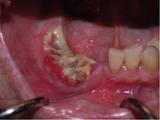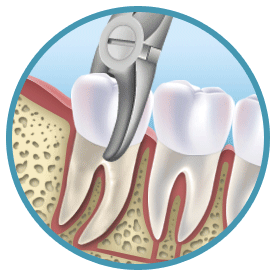This is a fistulous communication between the floor of the maxillary sinus to the oral cavity. This commonly occurs following dental extraction of infected upper molar and premolar tooth. From a small cavity at birth, the maxillary sinus starts to enlarge during the third month of foetal life and usually reaches maximum development around the eighteenth year. Its volume is approximately 20-25 ml in a normal adult. The floor of the sinus consists of the alveolar process and the hard palate. Continue reading
Category Archives: Teeth Extraction
Osteonecrosis of the Jaw Part 1
In this article we will be discussing questions about osteonecrosis of the jaw such as :
What is it?
How does it happen?
What are the causes & risks for osteonecrosis of the jaw?
What are bisphosphonates?
Should I be concerned if I am on bisphosphonates?
Why is osteonecrosis of the jaw dangerous?
The treatment and prevention of osteonecrosis of the jaw will be further discussed in the article “Osteonecrosis of the Jaw Part 2”.
What is osteonecrosis of the jaw?
“Osteonecrosis†is made up of the words “osteoâ€, which means bone, and “necrosis†which means death of cells. Hence “osteonecrosis†of the jaw bone means death of cells in the jaw bones. It is diagnosed when an area of bone is exposed and shows no sign of healing or gum growing over it 8 weeks after an invasive dental procedure, such as tooth extraction or implant surgeries. Both the upper and lower jaw may be affected, and it may be associated with pain, numbness, swelling and infection of the affected site. The damage to the jaw bone is irreversible, and if left untreated, can spread and can cause devastating damages, even to the point of death. Continue reading
Extraction of baby teeth
1. Why extract a baby tooth?
Choosing between extraction and filling or conservation is a very common decision that both dentists and patients have to take every day. With adults the decision making is much easier, if the tooth is restorable and the patient can pay for the treatment then we simply conserve the tooth. If the patient is a child then the process of decision making is much harder as many factors affect the selection of the treatment plan that the dentist have to follow. Continue reading
Compensating and Balancing Extractions
When a practitioner is faced with enforced extraction of a primary tooth it is often a dilemma whether to merely remove the unsaveable tooth , to extract a contralateral tooth from the same arch (balance), or to extract a tooth from the opposing arch (compensation). The following guidelines are intended to assist in making such a decision and to minimise the effect of space loss on the developing dentition. There have been no properly controlled prospective randomised studies into the consequences of early loss of primary teeth, probably due to the difficulty of recruiting subjects for such studies and the need to follow them for up to 10 years. The recommendations given are therefore based partly upon current clinical opinion, although this is supported where possible by the best available research data. There is a need for more research in the area. Continue reading
Abscess Tooth Symptoms
What is an Abscessed Tooth?
A tooth or dental abscess is a localized collection of pus in a sac formed by disintegration of purulent material from a bacterial infection. Invasion of bacteria which cannot be drained results in abscess. An abscessed tooth can be further classified into periapical, periodontal or gingival abscess depending on its location in the oral cavity.
- Periapical abscess: located at the apex of an infected tooth surrounding the roots. Continue reading
Teeth Extraction Techniques
Tooth extraction may sound easy but in fact experiences as well as the proper teeth extraction techniques are required to ensure that the tooth is safely out of the mouth. There are generally two methods of teeth extraction – simple or surgical extraction. Continue reading

